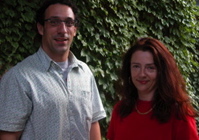Boosting Biosurveillance
BU prof hopes to build a better system to detect disease outbreaks

Information can be the most powerful weapon to combat a bioterrorist attack or pandemic influenza. To this end, the Centers for Disease Control and Prevention (CDC) has developed a nationwide biosurveillance system, BioSense, to provide early warnings and real-time information on disease outbreaks. Helping to improve the warning system is Alexander Ozonoff, a School of Public Health assistant professor of biostatistics, who along with co-investigator Paola Sebastiani, an SPH associate professor of biostatistics, received a $700,000 grant from the CDC. Ozonoff discussed the project with BU Today.
BU Today: What aspects of BioSense need improving?
Ozonoff: BioSense is a really ambitious project for CDC. Right now the program is working to invite more hospitals across the country to participate, which will expand coverage. The real problem that we, and other groups, are trying to address is what to do with all the data that are collected. The belief is that the signal of an important public health event, whether a bioterror attack or a massive outbreak of infectious disease, will be present in the BioSense data, but detecting that signal is a challenging statistical problem. Funding for this research project, and others like it, is meant to address that problem.
How early can you catch an event?
It’s not clear how early we can catch an event. The goal is always to improve timeliness (how early) along with sensitivity (don’t miss any events) and specificity (low false-alarm rate). We hope that improved statistical methods can improve on all three of these operating characteristics. In general, it’s hard to say how much early warning we can provide since each outbreak is very different.
Who decides on the standards for identifying threats, and what happens after a threat has been identified?
Determining what constitutes a threat to the public health is fundamental to BioSense, and to public health surveillance in general. There are two issues to deal with: first, if we see an increase in disease, or a geographic cluster of disease, is this increase due to chance (random variability in the number of people who are sick at any one time) or is it a signal of something important happening? This is where statistics play an important role. If we can say with some degree of confidence that the increase is not likely to be due to chance, then we must determine if it is important enough to act upon. These decisions are generally made by public health officials working together with statisticians and epidemiologists who are familiar with the surveillance system. So the decision-making process is intrinsically tied together with the collection, analysis, and interpretation of the data coming in. Each potential outbreak is generally considered on a case-by-base basis by public health officials at the local, state, or national level.
How does information get into the system, and what will it take to make this a nationwide network?
The BioSense infrastructure allows for data from multiple locations to be transmitted electronically to CDC, where the data can be analyzed centrally. Hospitals that agree to participate must meet the technical specifications determined by CDC in order to guarantee uninterrupted, consistent data flow. Right now, nationwide data from Department of Defense and the VA hospital system are part of the BioSense system, so in that sense it is already nationwide. As more hospitals from outside those two health-care systems are added, BioSense will continue to grow and expand its coverage to include more and more of the United States.